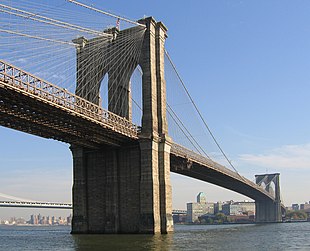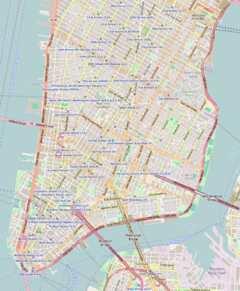Brooklyn Bridge
| Brooklyn Bridge | |
|---|---|

The Brooklyn Bridge, viewed from Manhattan
|
|
| Coordinates | 40°42′20″N 73°59′47″W / 40.70569°N 73.99639°WCoordinates: 40°42′20″N 73°59′47″W / 40.70569°N 73.99639°W |
| Carries | 6 lanes of roadway (cars only) Elevated trains (until 1944) Streetcars (until 1950) Pedestrians and bicycles |
| Crosses | East River |
| Locale | New York City (Civic Center, Manhattan – Dumbo/Brooklyn Heights, Brooklyn) |
| Maintained by | New York City Department of Transportation |
| ID number | 22400119 |
| Characteristics | |
| Design | Suspension/Cable-stay Hybrid |
| Total length | 5,989 ft (1,825.4 m) |
| Width | 85 ft (25.9 m) |
| Height | 276.5 ft (84.3 m) above mean high water |
| Longest span | 1,595.5 ft (486.3 m) |
| Clearance below | 135 ft (41.1 m) |
| History | |
| Designer | John Augustus Roebling |
| Opened | May 24, 1883 |
| Statistics | |
| Daily traffic | 123,781 (2008) |
| Toll | Free both ways |
|
Brooklyn Bridge
|
|
 |
|
| Built | 1883 |
| Architectural style | neo-Gothic |
| NRHP Reference # | 66000523 |
| Significant dates | |
| Added to NRHP | 1966 |
| Designated NHL | January 29, 1964 |
The Brooklyn Bridge is a hybrid cable-stayed/suspension bridge in New York City and is one of the oldest bridges of either type in the United States. Completed in 1883, it connects the boroughs of Manhattan and Brooklyn by spanning the East River. It has a main span of 1,595.5 feet (486.3 m) and was the first steel-wire suspension bridge constructed. It was originally referred to as the New York and Brooklyn Bridge and as the East River Bridge, but it was later dubbed the Brooklyn Bridge, a name coming from an earlier January 25, 1867, letter to the editor of the Brooklyn Daily Eagle and formally so named by the city government in 1915. Since its opening, it has become an icon of New York City and was designated a National Historic Landmark in 1964 and a National Historic Civil Engineering Landmark in 1972.
Although the Brooklyn Bridge is technically a suspension bridge, it uses a hybrid cable-stayed/suspension bridge design. The towers are built of limestone, granite, and Rosendale cement. The limestone was quarried at the Clark Quarry in Essex County, New York. The granite blocks were quarried and shaped on Vinalhaven Island, Maine, under a contract with the Bodwell Granite Company, and delivered from Maine to New York by schooner.
The bridge was built with numerous passageways and compartments in its anchorages. New York City rented out the large vaults under the bridge's Manhattan anchorage in order to fund the bridge. Opened in 1876, the vaults were used to store wine, as they were always at 60 °F (16 °C). This was called the "Blue Grotto" because of a shrine to the Virgin Mary next to an opening at the entrance. When New York visited one of the cellars about 102 years later, in 1978, it discovered, on the wall, a "fading inscription" reading: "Who loveth not wine, women and song, he remaineth a fool his whole life long."
...
Wikipedia




